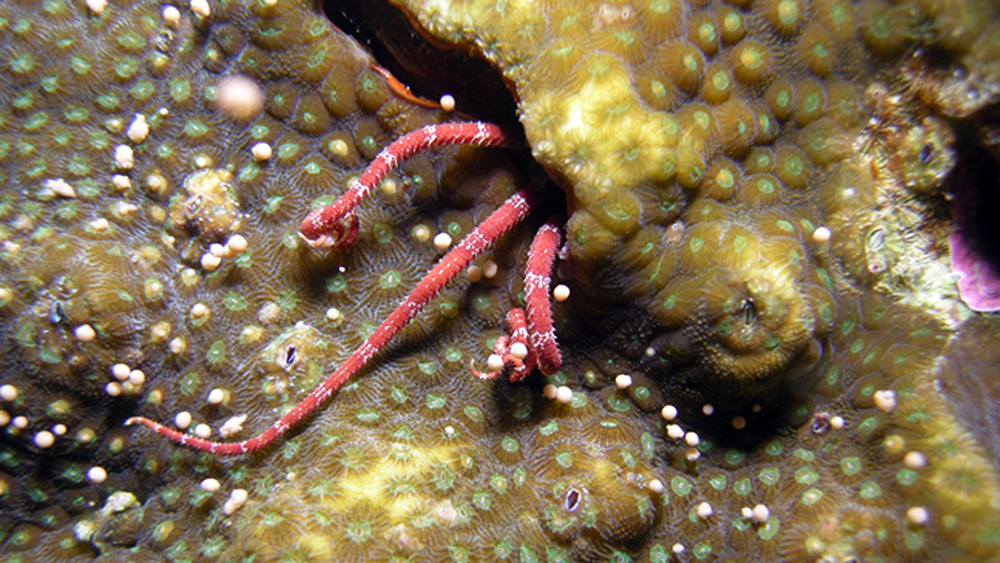
During the annual mass spawning event every August, 7-10 mights after the full moon, multiple species of star and brain corals release gametes (eggs and sperm) into the water at specific times over a period of several days, separated by species and sometimes by sex.
Since 1990, sanctuary researchers have been documenting this mass coral spawning event to accumulate more precise data on timing and species participation.
Species |
6th Night after Full Moon |
7th Night after Full Moon |
8th Night after Full Moon |
9th Night after Full Moon |
10th Night after Full Moon |
|---|---|---|---|---|---|
| Colpophyllia natans | 2020-2132 | 2030-2110 | |||
| Pseudodiploria strigosa | 2100-2215 | 1935-2230 | 1920-2230 | ||
| Orbicella annularis | 2223-2256 | 2246 | 2230 | ||
| Montastraea cavernosa (female) | 1950-2115 | 2059-2138 | 2040-2200 | 2104-2230 | |
| Montastraea cavernosa (male) | 2100 | 1830-2127 | 2030-2145 | 2140-2200 | |
| Orbicella faveolata | 2221-2320 | 2113-2330 | 2300-2600 | ||
| Orbicella franksi | 2145-2210 | 2100-2245 | 2030-2245 | 2100-2250 | |
| Stephanocoenia intersepta (female) | 2250 | 2208-2300 | 2200-2240 | 2215-2245 | |
| Stephanocoenia intersepta (male) | 2200-2220 | 2218-2300 | 2200-2300 | 2215-2245 |
Further observations are noted below, night by night.
7th Night
The primary mass spawning event typically begins on the 7th night after the full moon in August (and/or September), with the release of gametes by the Giant Star Coral (Montastraea cavernosa), beginning shortly after dark, at around 8:30 p.m. (although release has been observed as early as 6:30 p.m.). This species has separate sexes with male and female colonies releasing gametes within a similar time frame.
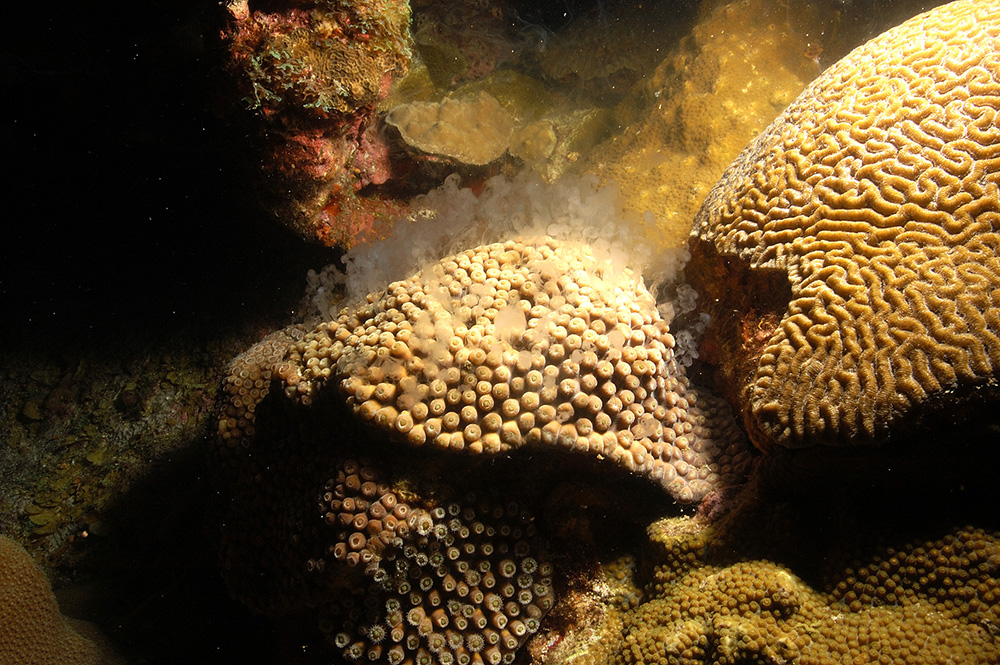
That same evening Boulder Star Coral (Orbicella franksi) and Symmetrical Brain Coral (Pseudodiploria strigosa) release gametes beginning around 9 p.m. Both of these species are hermaphroditic, with eggs and sperm packaged together in bundles.
O. franksi can display a particularly spectacular reproductive behavior, where gamete release occurs in a wave-like progression over a colony. Impressive video of this type of gamete release was featured in Howard and Michelle Hall’s IMAX film “Deep Sea 3D”.
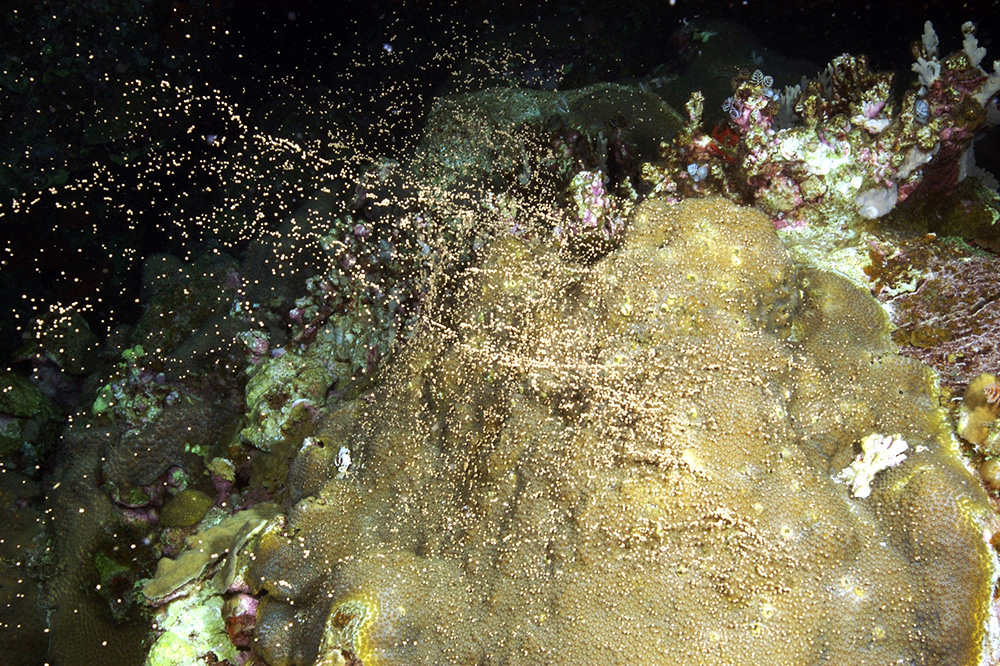
After about 10 p.m., male and female colonies of the Blushing Star Coral (Stephanocoenia intersepta) begin releasing their sperm and eggs. As the eggs release, the chocolate brown tentacles of the coral polyps withdraw making the colony appear to “blush” due to the white color of the underlying skeleton.
8th Night
On the 8th night after the full moon, the spawning sequence of the previous evening repeats itself, but with significantly more colonies releasing gametes. This is the peak night of the coral spawning event and is often described as an “underwater snowstorm”.
Also on the 8th night, the Mountainous Star Coral (Orbicella faveolata) releases its gamete bundles beginning shortly after 10 p.m. The separation in the timing between O. franksi and O. faveolata demonstrates the differing reproductive strategies of these two species.

Corals are not the only group to spawn at this time of year. Beginning at around 8:30 p.m. on the 8th night, Ruby Brittle Stars (Ophioderma rubicundum) release their gametes. The males aggregate in piles of a dozen or more on top of coral heads for a synchronized release of red smoky sperm.

At about the same time, individual female brittle stars climb to the tops of coral heads and stand on the very tips of their arms, releasing bright red eggs.
Video description: Male Red Serpent Brittle Stars (Ophioderma squamosissimus) "smoking," or releasing their sperm, into the water through small openings along the sides of their central disks, followed by, a female Ruby Brittle Star (Ophioderma rubicundum) standing up on the tips of her arms and releasing tiny, bright red eggs. (Video Length: 1:19; Credit: FGBNMS/Hickerson and Heidi Lydersen)
9th Night
Not yet well understood, or well documented, is what appears to be a mass spawning event of certain sponges. On several occasions, on the morning of the 9th day after the full moon, mass spawning of sponges has been documented at around 9:30 a.m.

In 2006, in both August and September, the Giant Barrel Sponge (Xestospongia muta) was observed spawning in large numbers. Females forcibly release eggs into the water column through their excurrent canals, which end up in “drifts” around the sponge colony. Males release so much sperm that the local visibility is reduced from well over 30 meters (100 ft) to about 3 meters (10 ft) in a short period of time.
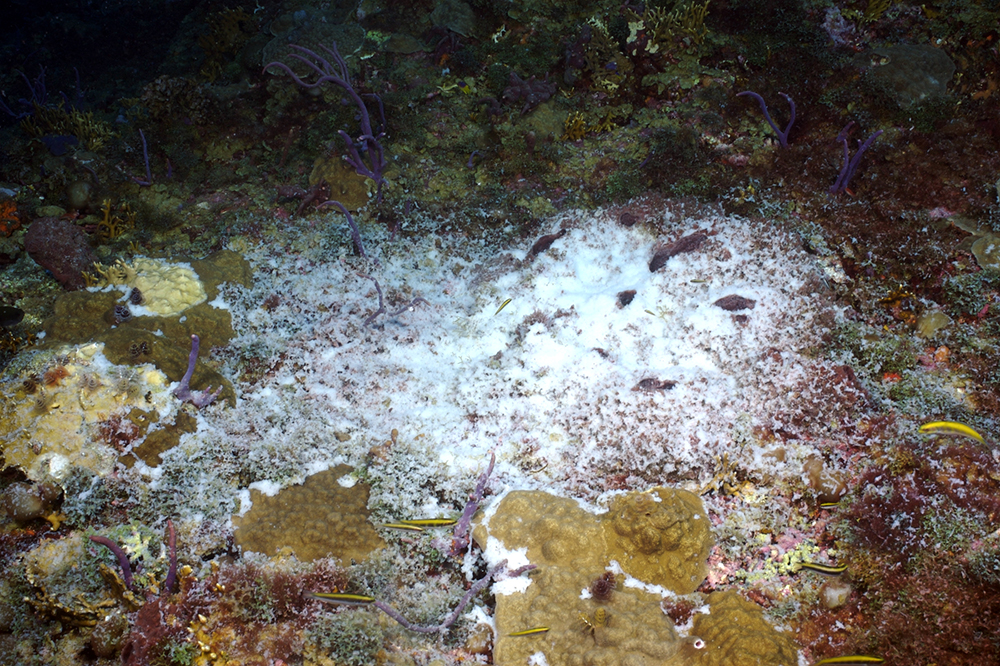
Video description: Spawning of a female then a male colony of the Giant Barrel Sponge (Xestospongia muta) followed by the spawning of a male colony of the Orange Elephant Ear Sponge (Agelas clathrodes). Spawning females look like snow blowers while spawning males resemble smokers. (Video Length: 0:32; Credit: FGBNMS/Hickerson)
On the 9th night after the full moon, gamete release by all of the previously mentioned coral species continues, but at greatly reduced levels, with the exception of the blushing star coral, Stephanocoenia intersepta, which appears to peak on this night.
A second, much larger species of brittle star, Ophioderma squamosissimus, also spawns on this particular evening, from about 8:30-9:30 p.m.
10th Night
The final major episode of the mass coral spawning event occurs on the 10th night after the full moon. On this night, the brain coral Colpophyllia natans releases egg and sperm bundles beginning around 8:30 p.m. This appears to be the primary night for this species. By this time, most of the other coral species, with the exception of Stephanocoenia intersepta, appear to have completed their spawning effort.
Video description: A male colony of Great Star Coral (Montastraea cavernosa) releases smoky, white sperm followed by a close-up view of a female colony of Great Star Coral releasing egg bundles. This is followed by star and brain coral species releasing BB-like bundles of both egg and sperm in the following sequence: Mountainous Star Coral (Orbicella faveolata) with a red Serpent Brittle Star (Ophioderma squamosissimus) perched on top; Boulder Star Coral (Orbicella franksi); Boulder Star Coral with a Christmas Tree Worm (Spirobranchus giganteus); Mountainous Star Coral; close-up of a star coral (Orbicella sp.); Blushing Star Coral (Stephanocoenia intersepta); Symmetrical Brain Coral (Pseudodiploria strigosa); a Ruby Brittle Star (Ophioderma rubicundum) snaking its way across a colony of star coral with one arm wrapped around a bunch of egg bundles; egg bundles streaming off various colonies of star corals and rising through the water column; a diver disappearing into the darkness behind a "snowstorm" of egg bundles. (Video Length: 2:02; Credit: FGBNMS/Hickerson, Schmahl)
Other Observations
Lobed Star Coral (Orbicella annularis) also participates in the mass spawning event, however, it releases its gamete bundles intermittently throughout the spawning window, and the specific timing of this species is less obvious.
Overall the mass spawning event produces an enormous amount of the reproductive material, although there has been no attempt to quantify it, so far.
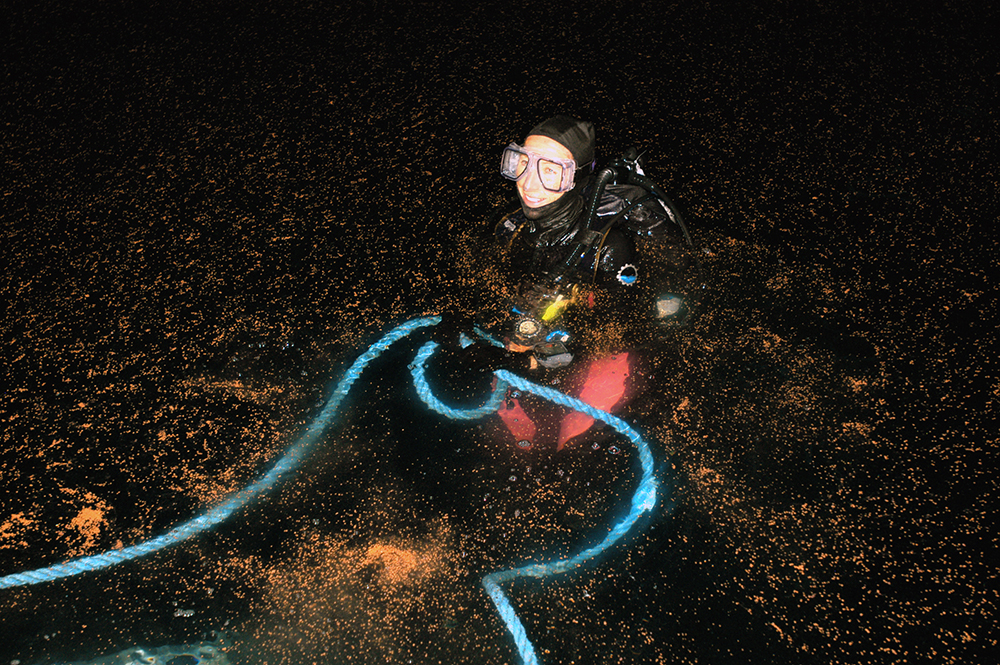
As odd as it seems, other than the occasional sightings of brittle stars (O. rubicundum) collecting gamete bundles with their arms (see header image), no other predation has been observed.

